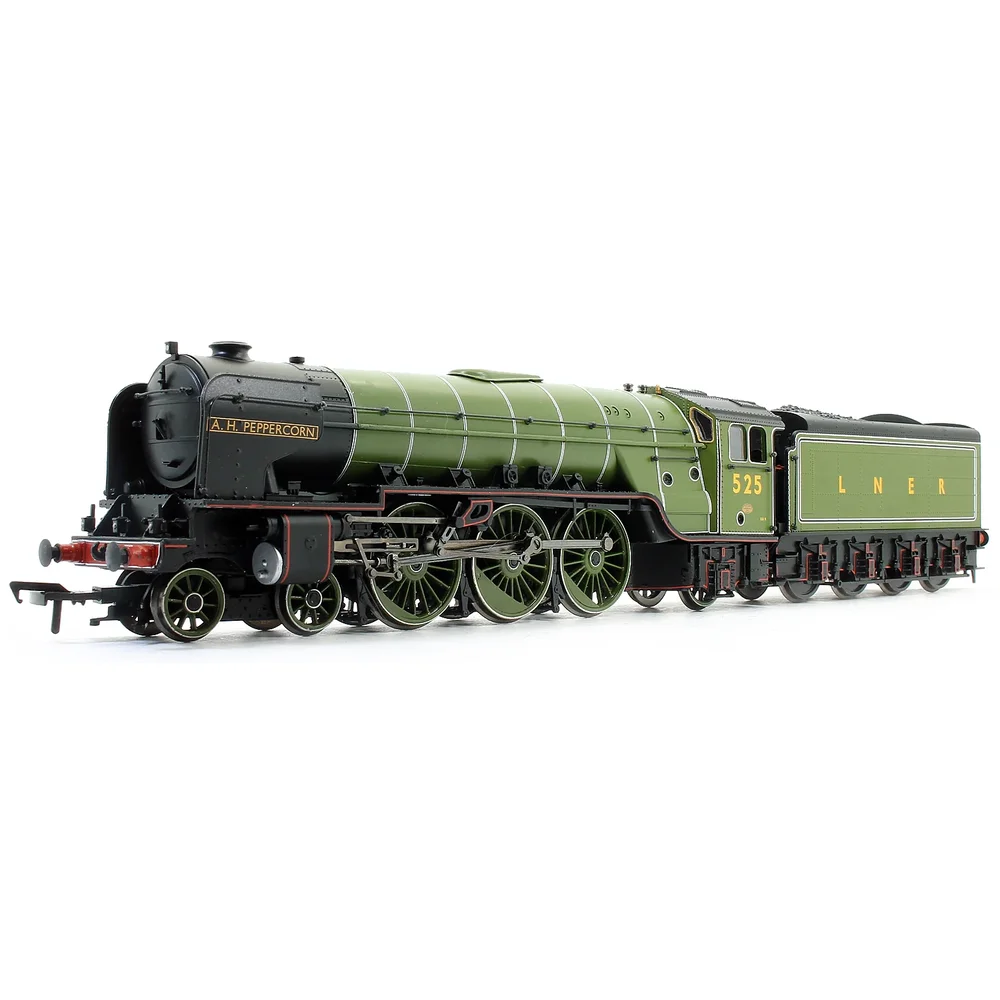Bachmann 31-525
London & North Eastern Railway A2 Peppercorn 525 A. H. Peppercorn London & North Eastern Railway Lined Apple Green
Tooling
The Bachmann Branchline Peppercorn A2 was introduced in 2010 as part of a new tooling initiative to represent the final evolution of LNER Pacific steam locomotives. Designed by Arthur Peppercorn, the A2 class was built between 1947 and 1948 and served under both LNER and British Railways. Bachmann’s model aimed to capture the distinctive features and elegance of these powerful express passenger locomotives.
Tooling Features
- Scale: OO Gauge (1:76)
- Construction: Combination of plastic and metal components, with a screw-assembled body including cast metal footplate and cab, and a plastic boiler.
- Detailing: Factory-fitted separate details including handrails, pipework, safety valves, whistles, bufferbeam detail, fluted connecting rods with oily finish, and a detailed cab interior with painted fallplate and glazing.
- Couplings: NEM pockets with tension lock couplings; cosmetic hook coupling on bufferbeam.
- Tender: Riveted tender with painted wheels and brake rigging; easy-to-use coupling to locomotive.
Mechanical & Electrical
- Motor: 3-pole motor located in the locomotive body.
- Drive: Loco-driven with pickups on driving wheels only.
- Minimum Radius: Compatible with second radius curves (approx. 438mm).
- Weighting: Internal chassis weighting to assist traction.
- Lighting: No directional or interior lighting fitted as standard.
DCC Capability
- Socket: DCC Ready with 8-pin NMRA/NEM 652 socket.
- Sound: No factory provision for speaker or sound decoder; some users have retrofitted sound systems in the tender.
Liveries Produced
- LNER Apple Green (e.g., 525 "A H Peppercorn")
- BR Green with Early Emblem (e.g., 60537 "Bachelors Button")
- BR Lined Green with Late Crest (e.g., 60533 "Happy Knight")
- BR Apple Green (e.g., 60528 "Tudor Minstrel")
- Preserved Livery (e.g., 60532 "Blue Peter")
Reviews & Commentary
- Initial reception praised the model’s fidelity to the prototype and crisp detailing.
- Some early examples exhibited minor cosmetic issues such as cab droop and misaligned handrails, which were correctable by users.
- Performance was generally smooth on DC, with good haulage capability and quiet running.
- Community feedback on forums like RMweb and New Railway Modellers highlighted the model’s visual appeal and mechanical reliability.
Media & Social Media
- Video reviews on YouTube showcased models such as 60532 "Blue Peter" and 525 "A H Peppercorn", noting strong finish and presentation.
- Custom upgrades including sound installations and lighting enhancements were shared by enthusiasts, demonstrating the model’s modding potential.
Additional Notes
- The 2010 tooling was later revised in 2012 with a 21-pin DCC socket and other refinements, which are covered separately.
- Limited edition releases, such as the wooden boxed "Blue Peter", added collector appeal.
Class & Prototype
- Class: London & North Eastern Railway A2 Peppercorn
- Traction: Steam
- Built: 1947-1948
- Total Built: 15
- Running Number: 525
- Name: A. H. Peppercorn
- Ordered By: London & North Eastern Railway
- Built By: London & North Eastern Railway
- Built At: Doncaster
- Built: 12/1947
- Withdrawn: 03/1963
- Length of Service: 15.3 years
- Running Numbers: LNER 525, BR 60525
- Names: A. H. Peppercorn
Operator & Livery
- Operator: London & North Eastern Railway
- Livery: Lined Apple Green
- Era: 3 - The big 4 – LMS, GWR, LNER & SR
The London & North Eastern Railway emerged in 1923 as Britain's second-largest railway company, combining seven major railways including the Great Northern, North Eastern, and Great Eastern into a 6,590-mile network stretching from London's four terminals to the Scottish Highlands. Despite serving economically challenged industrial regions, the LNER achieved worldwide recognition for engineering excellence and speed records that remain unbroken today.
Under Chief Mechanical Engineers Sir Nigel Gresley, Edward Thompson, and Arthur Peppercorn, the LNER developed revolutionary locomotive designs characterised by three-cylinder layouts and streamlined aesthetics. Gresley's masterpieces included the A1 Pacifics featuring Flying Scotsman and the legendary A4 class, culminating in Mallard's world steam speed record of 126 mph in 1938.
The company pioneered luxury express services including the Silver Jubilee and Coronation streamliners, whilst investing in forward-thinking electrification schemes and massive marshalling yards. Notable achievements included operating the complete East Coast Main Line, introducing Britain's first regular 400-mile non-stop service, and commissioning Eric Gill's iconic typography that influenced railway design for decades.
Nationalised in 1948, LNER locomotives continued serving British Railways until the 1960s, with some A4 Pacifics working Scottish expresses until 1966. Today, the LNER's engineering legacy thrives through extensive preservation, new-build projects like Tornado, and comprehensive model ranges covering every major class in all popular scales, making LNER subjects essential for discerning railway modellers seeking authentic British steam-age atmosphere.
